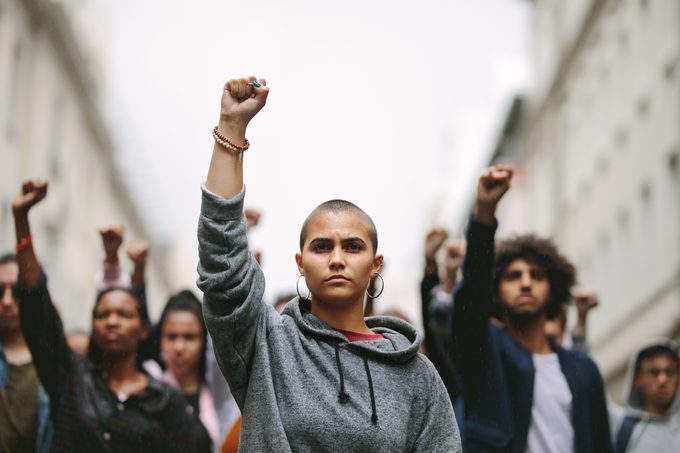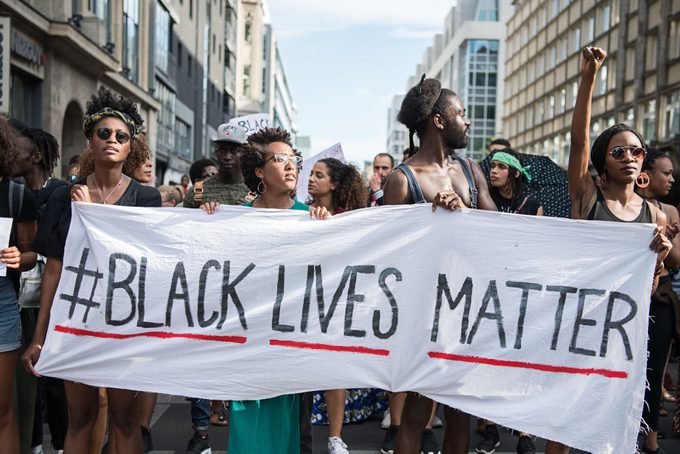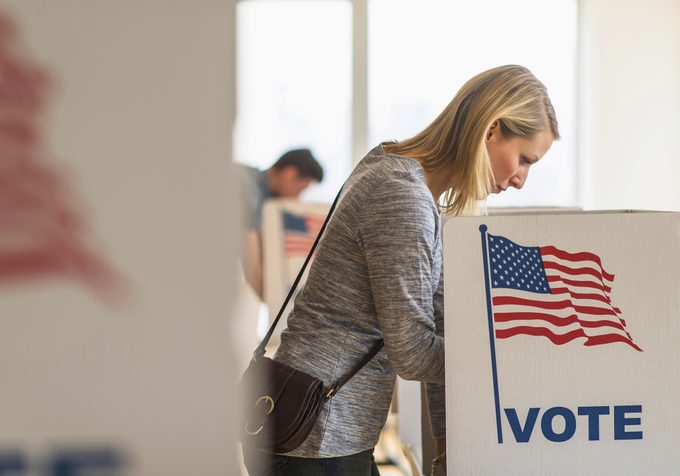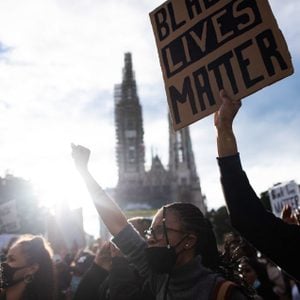12 Things You Can Do Right Now to Combat Racism
Updated: Jun. 24, 2020
To create meaningful change and combat racism, experts offer their tips to fight for social justice, from going to protests to voting.
Our editors and experts handpick every product we feature. We may earn a commission from your purchases.
How can one combat an insidious, omnipresent ideology like racism? If my son asked me this question, what could I tell him? In a way, I am at a loss for words. Everything I think of seems like a platitude, a bunch of words to throw on the slag heap of history. How can I answer him, meaningfully?
America is searching for answers, too. How can we do better? Should we defund or dismantle police departments, or not at all? How do we become anti-racist? Weeks after the deaths of Breonna Taylor, Ahmaud Arbery, George Floyd, and, most recently Rayshard Brooks, inflamed the nation, Black Lives Matter protesters continue to demand change. Still, fighting to right the wrongs resulting from America’s ugly, 250-year (and longer) history with racism, will take lots of undoing.

Social justice and race
At press time, senators were still bickering over the passage of a 100-year-old anti-lynching law. While Whites Only signs are long gone, white supremacy beliefs and their many manifestations are not. There’s the Ku Klux Klan and cop-calling Karens. Vast economic, healthcare, and housing disparities abound. And there’s no escaping racism in the workplace, either. There are microaggressions, or racially-charged insensitivities and insults, and macroaggressions, like hate crimes. The former, this writer has experienced plenty of. In kindergarten, a pint-sized schoolmate held a paper bag to my face and exclaimed, “You pass!”
There’s enough fear on both sides of the great divide to feed a developing nation. Tucker Carlson recently likened protesters to hornets who “will come for you.” And a video went viral of a 5-year-old black girl asking a white cop, “Are you gonna shoot us?”
How to create meaningful change
“We are in the midst of centuries of racialized oppression,” says Crystal Fleming, an associate professor of sociology and Africana studies at Stony Brook University, Stony Brook, New York, and author of How To Be Less Stupid About Race.
“I am cautiously optimistic that we are seeing a greater critical mass of people in this country—and across the world—acknowledge the gross injustices to which black people have been subjected. But there is still an enormous amount of work to be done.” So, where does one begin? Here are a few tips on how you can start to create meaningful change, right where you are.
Protest
Before you grab your handmade sign and head out, it’s best to prepare well before protesting. A cheat sheet from Amnesty International suggests must-haves are water bottles with squirt tops in the event of tear gas, as well as written-down emergency contacts like friends, family, and legal aid. For all its uncertainty and potential danger, the latest protests are working. Nearly three months after police officers barged into Breonna Taylor’s home and killed her in a hail of gunfire, Louisville lawmakers passed Breonna’s Law on June 11, banning no-knock warrants like the one the officers used. In the days after Floyd’s death, Minneapolis city council-members voted to dismantle their police department, and since then, other cities have announced they will reexamine their forces and procedures. After decades of secrecy, on June 12, New York’s Governor Andrew Cuomo signed a new law to lift the veil on police misconduct and make public the names of offending officers.

Start a social media campaign
What is now a global movement had earnest beginnings. After jurors acquitted George Zimmerman in Trayvon Martin’s death, Black Lives Matter (BLM) began in 2013—as a hashtag. Other campaigns have since shared in BLM’s message, like The African American Policy Forum (AAPF)’s initiative, #SayHerName, which shines a spotlight on black women lost to police violence and the celebrity-driven #ITakeResponsibility. Feeling inspired? There is plenty of online support to be found if you want to create a revolution of your own making, like Color of Change, and The Black Lives Matter Action Network, allowing organizers to build their awareness campaigns from the ground up and promote them.
Donate
Nothing says support like forking over a few Benjamins for a cause you believe in. From amplifying black voices to supporting victims’ families with financial burdens like funeral costs and legal fees, donation dollars are the very lifeblood of social justice-focused organizations. Since Floyd’s death, donors funneled $30 million into the Minnesota Freedom Fund, which supplies bail-outs for protesters and those unfairly incarcerated. Here is a list of ways to donate.
Read books
What’s the difference between white supremacy and white fragility? Anti-racism titles like How To Be An Antiracist, and So You Want To Talk About Race have quickly shot to the top of Amazon’s Best Sellers list. “Reading the work of a wide variety of scholars and activists is crucial for helping to address systemic racism in our society,” says Fleming, who urges buyers to purchase from people of color (POC)-owned bookstores and authors. “It’s especially important to read the work of black and brown writers, including black women and women of color. As I explain in [my book] How to Be Less Stupid About Race, most people in this country did not have an opportunity to learn about the history and present-day realities of racism in school. So we do have an educational crisis that we must collectively address.” Brooklyn Public Library makes things even easier, with curated anti-racism lists for adults, teens, and kids. But, Fleming warns, “reading is certainly not enough.”

Teach the next-gen about racism and anti-racism
Parents may feel uncertainty about whether or not to explain the scary images on TV, but now’s the perfect time to begin anti-racism education early and right at home. Experts say that parents can begin to discuss race with children as young as two. “It doesn’t just entail a conversation. It entails a lot of exposure in a multitude of ways,” explains Surrenca Albert, a Forest Hills, New York-based psychologist who specializes in culturally competent therapeutic interventions. “So, exposure meaning toys that are racially diverse. Books that are inclusive of race. Conversations about race and about culture. It is not just about race in terms of the negative, but also about the richness of Jamaican culture, Haitian culture, and African culture, so that children can understand the differences between people, but that differences aren’t a negative thing.” Parents can also take this time to reassess their feelings about other races and “widen their perspective,” she says.
“Your home is their world, so they’re picking up on every little thing they possibly can as far as your attitude, your tone, the jokes you make, the conversations you’re having with friends, they’re overhearing, so it’s a parent’s duty to be cautious as to how their managing racism within themselves and be honest with themselves about their biases.” Fleming urges change inside classrooms, too. “Parents, educators, and young people can all play a role in changing curricula in our schools to include readings and lessons related to racism and anti-racism.”
Try cognitive behavioral therapy
Albert says she has used cognitive behavioral therapy to treat patients who grappled with racism. Some of her patients had an eye-opening “‘black experience’ that really shattered their world view,” she says, like a bad encounter with police, or favoritism in the workplace, to spark their desire to change their ideas about race. “I think continued conversation around these kinds of individuals creates more tolerance, creates more of a widened perspective because unfortunately, I think that their perspective is very narrow because it’s self-serving.” Ultimately, however, Albert says letting go of long-held, destructive beliefs about race “is really up to an individual to make that change.”
Reach out to family, friends, and colleagues
Thanks to the latest spate of police brutality, many, especially, African Americans “are in the midst of a traumatic situation,” says Albert, adding that Covid-19 fears have already placed people in “active, acute trauma.” If you haven’t already, check-in on family, friends, and colleagues, especially POC. “It’s okay to say I’m not okay. It’s okay to take up space and take the cape off and have a real conversation about how you’re feeling because a lot of times, we mask it, and we avoid it, and that’s when it becomes detrimental.”
Tap into digital anti-racism resources
There are plenty of anti-racism resources online. A quick search of “free anti-racism webinars” on Eventbrite.com yielded 795 pages worth of results. There are also planned and impromptu “lives” to join in on Instagram and Facebook. There are TED Talks like this one featuring activist Bernice King, the daughter of the late Martin Luther King, Jr. There’s even a podcast called White Homework where listeners can write in with questions. Not only will you expand your knowledge on racism, but the resources can also “give you a sense of community,” during the Covid-19 crisis, says Albert, “because we need that.”

Vote
Are you registered to vote? Whatever your political affiliation, voting your preferred candidate into office can help bring about meaningful change, particularly in local and state offices. In a recent article for the internet platform, Medium, former President Barack Obama detailed how citizens can keep the momentum of the current movement going to change existing policies permanently.
“The elected officials who matter most in reforming police departments and the criminal justice system work at the state and local levels,” he writes. “It’s mayors and county executives that appoint most police chiefs and negotiate collective bargaining agreements with police unions. It’s district attorneys and state attorneys that decide whether or not to investigate and ultimately charge those involved in police misconduct. So the bottom line is this: if we want to bring about real change, then the choice isn’t between protest and politics. We have to do both.”
Sign a petition
Perhaps the easiest way to show your support to anti-racism causes is to simply sign your name to an online petition. A petition for Breonna Taylor has surpassed seven million signatures, while a new 200,000 signature-strong petition called for an investigation into the death of Robert Fuller, a Palmdale, California-man found hanging from a tree near the town’s city hall. Eerily, it’s the second hanging incident reported in recent weeks, as supporters of both petitions demand an independent investigation into the events leading to the deaths of both men.
Join an anti-racist organization
There are plenty of racial justice groups to support, like the NAACP (National Association for the Advancement of Colored People), Color for Change, and The National Urban League. Many of the organizations need help with registering voters before primary deadlines expire and ahead of Election Day.
And beyond the polls and ballots, “there is still an enormous amount of work to be done,” says Fleming, in putting racist acts on blast. “Black women and Black transgender people who are killed and harmed by police officers and others are not acknowledged often enough in discussions of racism and justice.”
Just…listen
Feelings of rage, betrayal, and oppression are palpable at every turn—across cities worldwide, on TV, and social media. What can soothe the masses? Good ‘ole communication. “We’re all at home; we’re not connecting with anyone. So we’re already kind of depressed and anxious because of Covid-19, and then we have racism and police brutality,” says Albert. “It causes you to feel like I don’t even want to go outside. I don’t even want to interact with people, but that could push you into a spiral that you want to counteract, and one way to do it is community, reaching out. You have to maintain connections with people.”



